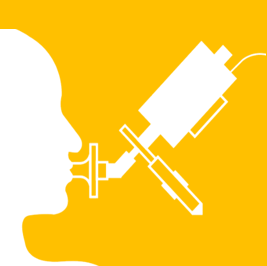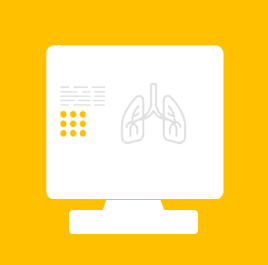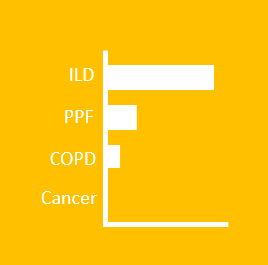BreathBase® Platform
Unlocking the potential of breath analysis for disease detection with advanced signal processing, cloud calibration, and an ever-expanding database
Contact us to explore how BreathBase® can support your research goals
Trusted and secure breath analysis
The BreathBase® Platform, designed by Breathomix in collaboration with technology leaders Microsoft and Tecknoworks, is an innovative solution for real-time breath analysis. Built on a secure IoT framework, BreathBase® works seamlessly with the SpiroNose, connecting through an IoT-enabled Gateway that routes breath measurement data directly to a cloud-based processing component for advanced analysis and interpretation.
BreathBase® is engineered for real-time, AI-powered analysis, delivering diagnostic insights to users within seconds. The platform leverages sophisticated signal processing and artificial intelligence (AI) to transform breath data into reliable, actionable insights. This high-speed processing and feedback system is invaluable for researchers and clinicians seeking precise, immediate data for their studies.
Commitment to Data Security and Compliance
Data security is at the heart of BreathBase®. Hosted in the Microsoft Azure Western Europe data center in the Netherlands, BreathBase® provides a centralized, secure environment for managing and sharing data. The platform is designed to meet stringent healthcare and data protection standards, including ISO 27001 and NEN 7510, ensuring that sensitive information remains protected at every stage. Breathomix’s close partnership with Microsoft and Tecknoworks ensures that the platform is continuously updated to maintain the highest standards of security, scalability, and reliability.
Validated and Trusted by Leading Researchers
BreathBase® has been rigorously tested and validated in numerous studies, supporting a growing community of researchers worldwide who rely on the platform for high-quality breath analysis. Its robust, user-friendly design offers a turn-key solution, adaptable to clinical and academic settings, and accessible to research partners around the globe.
BreathBase® Solution: All-in-One Breath Analysis Solution




SpiroNose®: The process starts with a simple breath maneuver into the SpiroNose®. The device’s sensors instantly detect the full mixture of VOCs in the exhaled breath.
BreathBase® Platform: The captured sensor data is transmitted in real-time to this online analysis platform, where it is processed into a comprehensive breath profile.
BreathBase® Data: The breath profile is compared with a comprehensive reference database of breath samples and clinical data, carefully compiled based on rigorous scientific research.
Report: Within seconds, the BreathBase® Solution generates a diagnostic report, providing insights into potential conditions like ILD, PPF, COPD, and various cancers.
Advantages of BreathBase® over other Breath Analysis Technologies
The BreathBase® Platform offers a range of unique advantages over traditional breath analysis technologies, making it an ideal solution for both research and clinical applications in breath diagnostics.
1. Cost-Efficiency and Continuous Learning
BreathBase® is a cost-effective breath analysis solution that improves with every new breath profile added to its reference database. This continuously expanding database not only enhances diagnostic accuracy but also creates opportunities for discovering new applications. For example, Breathomix has collected valuable data on conditions like diabetes (often present as a co-morbidity), enabling initial analyses.
2. Direct VOC Measurements and Practical Relevance
A key advantage of BreathBase® is its ability to measure volatile organic compounds (VOCs) in breath directly, eliminating the risk of errors associated with sample storage and transport. The mostly real-world data collected by BreathBase® is highly relevant for everyday medical practice, providing clinicians and researchers with actionable insights that are directly applicable.
3. Fully Automated and Scalable Breath Analysis
BreathBase® is fully automated, delivering breath analysis results within seconds—an essential feature for applications that require immediate feedback. The platform is designed to handle high throughput, processing thousands of tests simultaneously, and can easily be scaled to accommodate very large studies. This makes BreathBase® suitable for both clinical settings and academic research.
4. Clinical Relevance and Proven Diagnostic Accuracy
With proven clinical relevance, the BreathBase® Solution demonstrates high diagnostic accuracy across various applications. Its advanced pattern recognition algorithms are highly suitable to filter out chemical noise and identify specific VOC patterns with high precision, enhancing its reliability and clinical applicability.
5. Unique Benefits Over Mass Spectrometry for Breath Analysis
While mass spectrometry (MS) is in some cases effective for identifying
individual VOCs and conducting pathophysiological research, it requires offline laboratory procedures, specialized personnel, and high costs, which limit its clinical applicability. The BreathBase® Solution uses eNose technology that bypasses the need to identify individual VOCs, instead analyzing the entire VOC profile through pattern recognition. This makes it fast, affordable, and highly suitable for point-of-care breath diagnostics.
6. Stability and Reproducibility of VOC Measurements
Unlike other eNose technologies, which often face stability and reproducibility challenges, the BreathBase® Solution has demonstrated consistent performance. The SpiroNose® sensor platform delivers stable and reproducible data, and the BreathBase® algorithms show strong transferability between devices. This ensures seamless data exchange across labs and locations, a critical requirement for clinical implementation of breath analysis.
7. Real-Time Feedback for Point-of-Care Diagnostics
BreathBase® supports real-time, online analysis of SpiroNose sensor data, providing immediate feedback at the point-of-care. This enables fast decision-making and supports precision medicine.
8. Advanced Pattern Recognition Inspired by the Human Olfactory System
The BreathBase® Solution uses cross-reactive, non-specific sensor arrays that respond to the full mixture of VOCs, similar to the human olfactory system. This approach generates a unique sensor pattern, allowing probabilistic analyses that are ideally suited for clinical diagnostics and precision medicine applications in breath analysis.
In summary, the BreathBase® Platform overcomes many of the limitations associated with traditional breath analysis technologies. With its cost-effectiveness, direct VOC measurement approach, scalability, and proven clinical relevance, BreathBase® sets a new standard for breath analysis in both research and future clinical applications.
